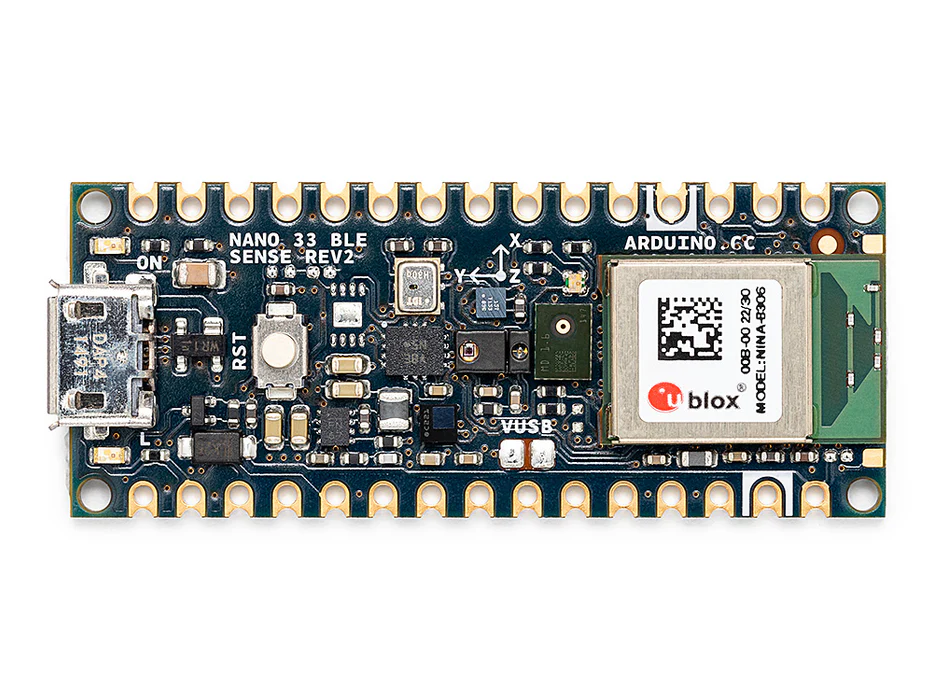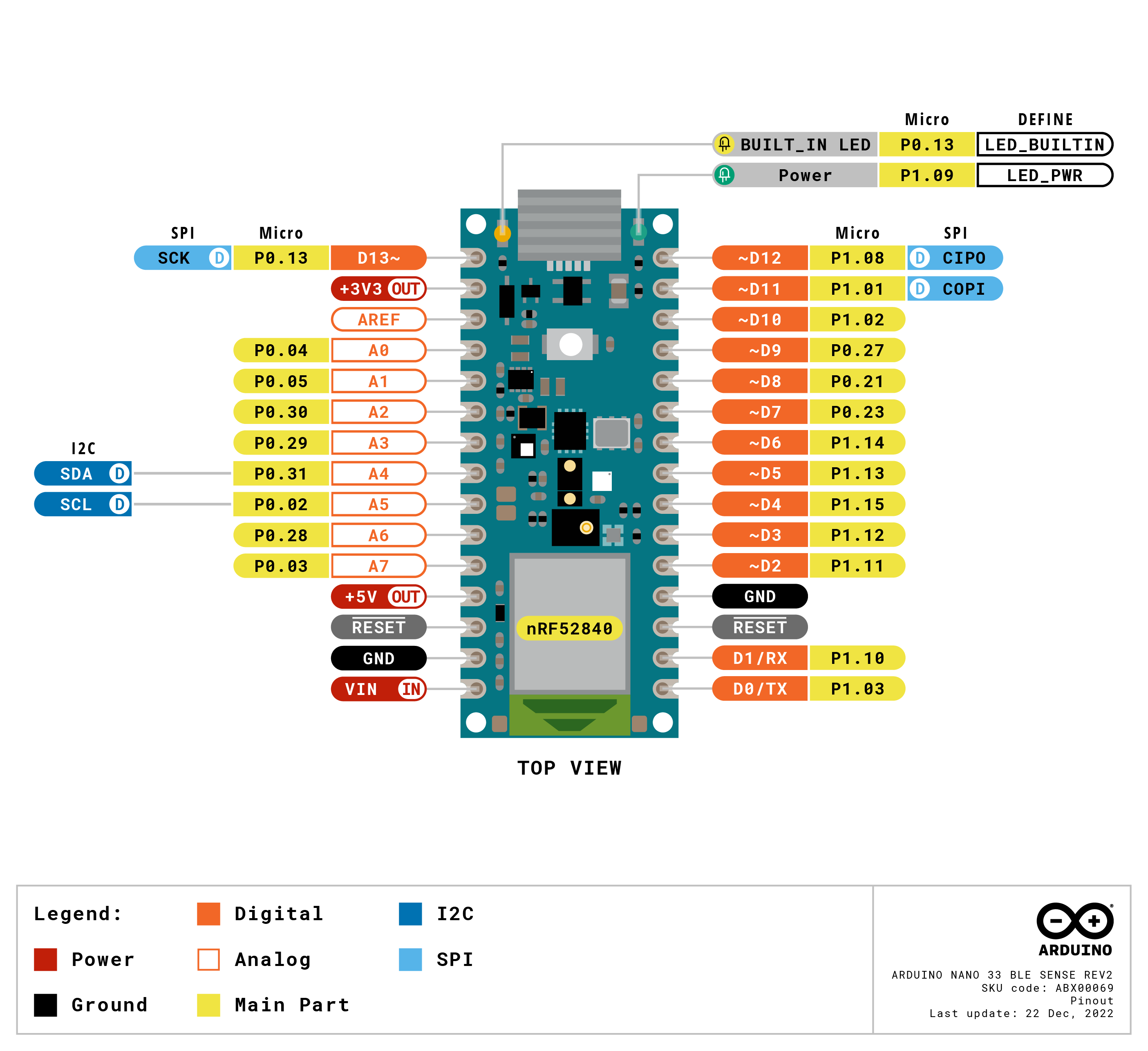
Arduino Nano 33 BLE Sense Rev2
An AI enabled board in the shape of the classic Nano board, with all the sensors to start building your next project right away.
Overview
The Arduino Nano 33 BLE Sense Rev2 is Arduino’s 3.3V AI enabled board in the smallest available form factor with a set of sensors that will allow you without any external hardware to start programming your next project, right away.
With the Arduino Nano 33 BLE Sense Rev2, you can:
- Build wearable devices that using AI can recognize movements.
- Build a room temperature monitoring device that can suggest or modify changes in the thermostat.
- Build a gesture or voice recognition device using the microphone or the gesture sensor together with the AI capabilities of the board.
The main feature of this board, besides the complete selection of sensors, is the possibility of running Edge Computing applications (AI) on it using TinyML. Learn how to use the Tensor Flow Lite library following this instructions or learn how to train your board using Edge Impulse.
Tech specs
|
Microcontroller |
nRF52840 (datasheet) |
|
Operating Voltage |
3.3V |
|
Input Voltage (limit) |
21V |
|
DC Current per I/O Pin |
15 mA |
|
Clock Speed |
64MHz |
|
CPU Flash Memory |
1MB (nRF52840) |
|
SRAM |
256KB (nRF52840) |
|
EEPROM |
none |
|
Digital Input / Output Pins |
14 |
|
PWM Pins |
all digital pins |
|
UART |
1 |
|
SPI |
1 |
|
I2C |
1 |
|
Analog Input Pins |
8 (ADC 12 bit 200 k samples) |
|
Analog Output Pins |
Only through PWM (no DAC) |
|
External Interrupts |
all digital pins |
|
LED_BUILTIN |
13 |
|
USB |
Native in the nRF52840 Processor |
|
IMU |
|
|
Microphone |
MP34DT06JTR (datasheet) |
|
Gesture, light, proximity, color |
APDS9960 (datasheet) |
|
Barometric pressure |
LPS22HB (datasheet) |
|
Temperature, humidity |
HS3003 (datasheet) |
Conformities
Resources for Safety and Products
Manufacturer Information
The production information includes the address and related details of the product manufacturer.
Arduino S.r.l.
Via Andrea Appiani, 25
Monza, MB, IT, 20900
https://www.arduino.cc/
Responsible Person in the EU
An EU-based economic operator who ensures the product's compliance with the required regulations.
Arduino S.r.l.
Via Andrea Appiani, 25
Monza, MB, IT, 20900
Phone: +39 0113157477
Email: support@arduino.cc
Documentation
Learn more
Get Inspired

Our team at Embedded World (April 9th-11th in Nuremberg) has announced not one, but two groundbreaking additions to the Arduino Pro range that are ready to elevate your prototyping and connectivity experiences. Say hello to the Arduino Portenta Mid Carrier and the Arduino Pro 4G Module! Portenta Mid Carrier: maximizing prototyping potential This ultimate companion to the Portenta boards family is your gateway to seamless prototyping and expanded connectivity, designed to grant you zero hassles and maximum efficiency. From CAN lines to Ethernet, microSD, USB, camera interfaces, and more, it allows you to effortlessly tap into high-density signals through dedicated headers. Plus, debug pins and the RTC battery backup will simplify your development journey even more. Compatible with Portenta C33, Portenta H7, and Portenta X8, it adapts to your evolving development needs with ease. Whether you’re delving into machine vision prototyping or testing cellular connectivity, this is the carrier for you. Find out more from the dedicated page, or head straight to the store. Arduino Pro 4G Module: revolutionizing connectivity Are you ready to revolutionize your connectivity game? Engineered to seamlessly integrate with the Portenta family, the Arduino Pro 4G Module comes with a plethora of benefits, ensuring your projects thrive with lightning-fast data throughput and high bandwidths, powered by a robust Cat.4 modem from Quectel. Enjoy secure data transfer, long-range global coverage even in the most isolated locations, and cost-efficient flexibility – all in the widely adopted Mini PCIe form factor: from remote maintenance to building safety inspection, the possibilities are endless. The full details are available on our website, but you can also jump right to purchase from the Arduino Store! Embark on your journey of innovation with Arduino’s expanding ecosystem Our end-to-end ecosystem of hardware, software, and cloud
FAQs
What is the difference between Rev1 and Rev2?
There has been some changes in the sensor between both revisions:
- Replacement of IMU from LSM9DS1 (9 axis) for a combination of two IMUs (BMI270 - 6 axis IMU and BMM150 - 3 axis IMU).
- Replacement of temperature and humidity sensor from HTS221 for HS3003.
- Replacement of microphone from MP34DT05 to MP34DT06JTR.
Additionally some components and the changes have been done in order to improve the experience of the users:
- Replacement of power supply MPM3610 for MP2322.
- Addition of VUSB soldering jumper on the top side of the board.
- New test point for USB, SWDIO and SWCLK.
Do I need to change my sketch used in the previous revision?
For sketches done using the libraries like LSM9DS1 for the IMU or HTS221 for the temperature and humidity sensor, for the new revision this libraries must be changed to Arduino_BMI270_BMM150 for the new combined IMU and Arduino_HS300x for the new temperature and humidity sensor.










